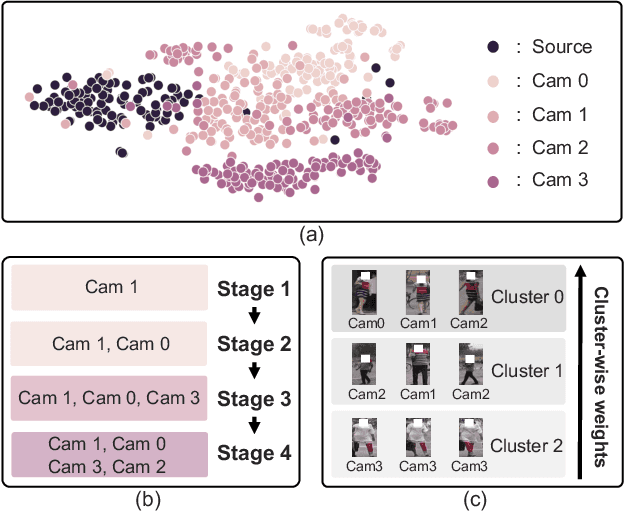Yongsang Yoon
Camera-Driven Representation Learning for Unsupervised Domain Adaptive Person Re-identification
Aug 23, 2023



Abstract:We present a novel unsupervised domain adaption method for person re-identification (reID) that generalizes a model trained on a labeled source domain to an unlabeled target domain. We introduce a camera-driven curriculum learning (CaCL) framework that leverages camera labels of person images to transfer knowledge from source to target domains progressively. To this end, we divide target domain dataset into multiple subsets based on the camera labels, and initially train our model with a single subset (i.e., images captured by a single camera). We then gradually exploit more subsets for training, according to a curriculum sequence obtained with a camera-driven scheduling rule. The scheduler considers maximum mean discrepancies (MMD) between each subset and the source domain dataset, such that the subset closer to the source domain is exploited earlier within the curriculum. For each curriculum sequence, we generate pseudo labels of person images in a target domain to train a reID model in a supervised way. We have observed that the pseudo labels are highly biased toward cameras, suggesting that person images obtained from the same camera are likely to have the same pseudo labels, even for different IDs. To address the camera bias problem, we also introduce a camera-diversity (CD) loss encouraging person images of the same pseudo label, but captured across various cameras, to involve more for discriminative feature learning, providing person representations robust to inter-camera variations. Experimental results on standard benchmarks, including real-to-real and synthetic-to-real scenarios, demonstrate the effectiveness of our framework.
Predictively Encoded Graph Convolutional Network for Noise-Robust Skeleton-based Action Recognition
Mar 17, 2020



Abstract:In skeleton-based action recognition, graph convolutional networks (GCNs), which model human body skeletons using graphical components such as nodes and connections, have achieved remarkable performance recently. However, current state-of-the-art methods for skeleton-based action recognition usually work on the assumption that the completely observed skeletons will be provided. This may be problematic to apply this assumption in real scenarios since there is always a possibility that captured skeletons are incomplete or noisy. In this work, we propose a skeleton-based action recognition method which is robust to noise information of given skeleton features. The key insight of our approach is to train a model by maximizing the mutual information between normal and noisy skeletons using a predictive coding manner. We have conducted comprehensive experiments about skeleton-based action recognition with defected skeletons using NTU-RGB+D and Kinetics-Skeleton datasets. The experimental results demonstrate that our approach achieves outstanding performance when skeleton samples are noised compared with existing state-of-the-art methods.
 Add to Chrome
Add to Chrome Add to Firefox
Add to Firefox Add to Edge
Add to Edge